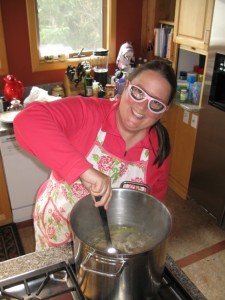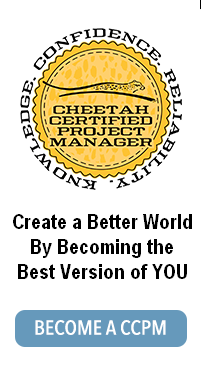The Chicken Noodle Soup Project
Wednesday, May 6th, 2009Michelle LaBrosse, PMP
I am considering using cooking to help people develop project management as a habit. I’ve often wondered if you become a good cook because you’re good at project management or if you become a good project manager because you’re good at cooking?There are five phases to every project – initiation, planning, execution, control and closeout. Every meal or dish you create is itself a project – you get an idea for what you want to make (you initiate it), you have to figure out the ingredients and equipment, go procure anything you need to prepare the meal, and figure out when and where you’re going to make it (this is planning), then you have to prepare the meal (this is project execution), then you have to make sure it tastes like you wanted it to (project control), then you assess how you can make it better the next time (project close out).
I have found time and time again, that the more successful people are with the smaller projects of their life, the more likely they will be successful with the larger projects of life. So it just makes sense to teach people how to be more successful with the smaller projects of their life – like cooking.
For the first attempt to teach project management with cooking, I am going to revisit a concept I posted several days ago on flu remedies, my recipe for Chicken Noodle Soup.
Project Initiation is the first phase of the Chicken Noodle Soup Project.
In initiating the Chicken Soup Project, I wanted to do a bit of research as to just why Chicken Noodle Soup has been a cold and flu cureall for centuries. I had my trusty intern – Erica research this. Here is what she found:
We have all heard that when we are ill, a bowl of chicken noodle soup is a comforting remedy. Chicken noodle soup has a long history of relieving symptoms associated with various illnesses. During the 12th century, healers began recommending ‘the broth of fowl’ to their patients. Also around this time, Rabbi Mosche ben Maimonides, an Egyptian Jewish physician and philosopher, wrote about the many benefits of chicken noodle soup. He used chicken soup to treat a variety of illnesses including respiratory problems like the common cold.
Present day researchers have set out to determine whether or not chicken noodle soup actually does have medicinal uses. One pulmonary specialist, Irwin Ziment, M.D., who is also a professor at the UCLA School for Medicine, found that chicken soup contains contains an amino acid that is similar to a drug called acetylcysteine that is prescribed for respiratory illnesses such as bronchitis. This amino acid is released from the chicken when it is cooked and heated. Another pulmonary specialist who has spent time studying the benefits of chicken noodle soup is Stephen Rennard, M.D. He is the chief of pulmonary medicine at the University of Nebraska Medical Center in Omaha. Rennard found that chicken soup has anti-inflammatory properties. Colds and respiratory illnesses are many times caused by inflammation from neutrophils (inflammatory white blood cells) that travel to the bronchial tubes. Rennard used a chicken noodle soup recipe from his wife’s grandmother to show that neutrophils were less likely to accumulate when chicken soup was added.
Chicken noodle soup is also a useful cold remedy because it contains bacteria and virus fighting ingredients including garlic and onions. Garlic is a natural antibiotic for which the body does not develop resistance. Onions contain an anti-oxidant called quercetin that also acts as an anti-inflammatory.
Even though chicken noodle soup is not a cure for a common cold, it has been proven to alleviate many symptoms that come along with a cold. It keeps you hydrated, can clear your nasal passageways, and acts as an anti-inflammatory.
To read more about the research conducted by Rennard, you can read the entire study at http://www.chestjournal.org/content/118/4/1150.full
To learn more about the health benefits of chicken noodle soup, you can go to the following websites:
http://www.sixwise.com/newsletters/05/12/14/does_chicken_soup_have_healing_powers_004.htm
http://chetday.com/coldfluremedy.htm
After I had my curiousity sufficiently satisfied that Chicken Noodle Soup was a good thing to make and a good recipe to share with others, I got about planning how I would make it.
Project Planning – to make the chicken noodle soup I had to do a number of preparations – like I would for any other project.
Make sure I had all the ingredients:
Whole Chicken
1 tsp fresh ground pepper
2 quarts of water
2 tsp iodized salt
2 tbs whole peppercorns
2 tbs butter
1 bunch of celery
1 large onion
5 cloves of garlic
1 cup dry whole wheat egg noodles
Use the correct tools to reduce risk and improve the quality of the final product
1 roasting pan
2 pot holders
Oven pre-heated to 450 degrees
Apron
Cooking safety glasses
4 quart stock pot
Clean cutting board and sharp carving knife
Set my schedule and budget. Usually I make chicken noodle soup from the leftovers from a roast chicken meal so the cost of the extra ingredients are minimal. The most important thing though is the schedule as to develop the most savory broth. I usually let the chicken carcass simmer on very low heat overnight. So making chicken noodle soup definitely is a “project.”
Project Execution – here are the steps I take to make Chicken Noodle soup:
1. Roast the chicken – clean and dry one whole chicken, sprinkle it with pepper and place it in the roasting dish. Put roasting dish in the pre-heated 450 degree F oven. Cook at that temperature for 15 minutes then turn temp down to 350 degrees F. This sears the skin keeping the interior meat moist. The chicken is done when you can easily pull the drumstick off the chicken.
2. Remove most of the meat off the chicken carcass. Either serve the meat for dinner, or cover and put into the refrigerator – you will use it later for the soup. Toss the chicken carcass and the roasted skin into the 4 quart stock pot. Fill enough water to cover the chicken carcass.
3. Put the whole peppercorns, the salt and three whole stalks of celery into the stock pot with the chicken carcass. Cover and put on low heat overnight or for at least 5 hours.
4. In the morning or after 5 hours or so, strain the chicken broth, Keep the liquid and discard the bones, peppercorns and celery stalks.
5. Put in the refrigerator until you return home from work or after 5 or 6 hours. The chilling allows the fat to rise to the surface where it’s easier to skim off to make a lighter soup.
6. Chop the celery and onion into small 1/4 inch pieces. Saute in 2 tbs butter until the onions are translucent.
7. Put in the chicken broth. Crush the cloves of garlic and add them in the chicken broth.
8. Bring the chicken broth to a boil and add the noodles. Cook until the noodles are done.
9. Dice up the remaining chicken to 1/2 inch bite size pieces. (this is the chicken you pulled off the chicken before making the broth that you refrigerated). Put at least 1 cup of it into the soup.
Project Control
Salt to Taste – everyone’s taste for salt varies so it’s better to let people spice up their soup on their own. Tabasco sauce in the soup is also good.
A big part of cooking (and project management) is quality control. It starts with getting high quality ingredients, having the caliber of tools that help you create better results and using techniques that provide a higher quality outcome. The more you do both project management and cooking, the higher quality output you create. And when you combine the two, in the spirit of creating a high quality product, you get better at both.
Project Closeout
At the end of a meal, I review how I did and if I should do anything different the next time. One time, I put yams in my chicken noodle soup – they were an over powering presence. I have found the same with carrots. This is why I just stick with onions, celery, garlic and noodles.
For this go round with my chicken noodle soup – I was just showing my intern how to make it and we were testing out the idea of creating a video around this as well. I learned, that usually I make chicken noodle soup more as just part of making a roasted chicken dinner and doing it as a demonstration project – I ended up with a LOT of left over chicken. I am going to use it to make chicken salad for lunch tomorrow.
The soup came out GREAT – we served it with whole wheat saltines.


